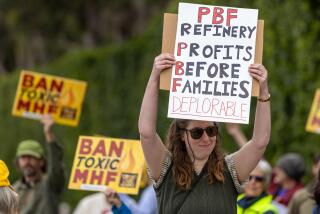Delay in Giving Alarm in Gas Leak Is Charged : Substance Rated as Highly Toxic Despite Union Carbide Claim
- Share via
WASHINGTON — Union Carbide Corp., its credibility severely battered by Sunday’s gas leak at a supposedly accident-proof chemical plant in Institute, W. Va., came under renewed assault Monday from environmental and congressional critics for its handling of the incident.
The criticism was fueled by the disclosure that the escaped gas, aldicarb oxime, is rated by company safety experts as among the most toxic chemicals that Union Carbide uses, despite a company description of the chemical on Sunday as “an eye and lung irritant” of low toxicity.
On Par With MIC
The firm’s 1983 guidelines on chemical hazards rank the gas on a par with methyl isocyanate, or MIC, the gas that killed 2,500 persons last December in Bhopal, India.
Top federal officials, including Environmental Protection Agency Administrator Lee M. Thomas and Senate Minority Leader Robert C. Byrd (D-W. Va.), were to tour Institute today, as EPA and Occupational Safety and Health Administration teams entered a third day of investigations.
Meanwhile, in Washington, critics of the chemical industry said that the Institute accident could renew a blunted effort to enact laws governing safety in the industry.
“In a plant which you’d expect to be the most carefully manicured plant in the country, you can still have a major industrial accident. What that tells me is that this industry cannot police itself,” said David Doniger, staff attorney with the Natural Resources Defense Council in Washington.
“It’s clear to me . . . that the chemical companies are reckless with their products,” said an aide to Rep. Henry A. Waxman (D-Los Angeles), a critic of the chemical industry. “And eventually people are going to realize it when this happens often enough.”
Waxman has introduced legislation to curb toxic air pollutants and require safeguards against Bhopal-style accidents. The bill has been stalled in the House Commerce Committee by opposition from chemical industry groups and committee Chairman John D. Dingell (D-Mich.).
Importance Played Down
But a chemical industry lobbyist who asked not to be named played down the accident’s political importance.
“What happened in West Virginia was nothing compared to what happened in Bhopal,” she said. “Nobody was killed, and it wasn’t something that happened because the plant didn’t work.”
The cause of the accident--and whether there was a delay in warning Institute residents--was still at issue Monday. But the incident is being likened to Bhopal because the Institute facility was a model for the Indian plant and because components that failed to consume the escaping gas--scrubbers and burning flares--also failed at Bhopal.
After that incident, OSHA, EPA and state experts scoured the Institute factory for safety defects. Union Carbide Chairman Warren M. Anderson assured legislators last spring that the plant was a model factory.
Incident Minimized
On Monday, company officers scurried to minimize the incident’s seriousness and their roles in failing to prevent it.
Union Carbide spokesman Dick Henderson said that the Institute plant would not be shut down, adding: “You don’t close the whole operation because of a little hysteria over a little leak.”
An OSHA spokesman said the aldicarb leak was not in an area inspected by the agency after the Bhopal disaster because the inspectors examined only the MIC production line.
“Working at a chemical plant is much safer than a lot of other jobs people work at, such as construction,” the spokesman, Jack McDavitt, said.
Top Hazard Rating
Union Carbide safety experts have given aldicarb oxime a hazard rating of 4 on a scale of 1 to 4, the same as MIC. Chemicals with a rating of 4 include those which “are predominantly fast-acting and can cause major injury.”
A company spokesman said that aldicarb oxime actually is less toxic than MIC but was rated acutely hazardous because of its potential to injure eyes and lungs and because “you have to put it somewhere” in the company’s internal rating system.
The EPA, which apparently has not tested the chemical’s gaseous form, says that it is of low toxicity when fed to laboratory animals.
More to Read
Inside the business of entertainment
The Wide Shot brings you news, analysis and insights on everything from streaming wars to production — and what it all means for the future.
You may occasionally receive promotional content from the Los Angeles Times.










